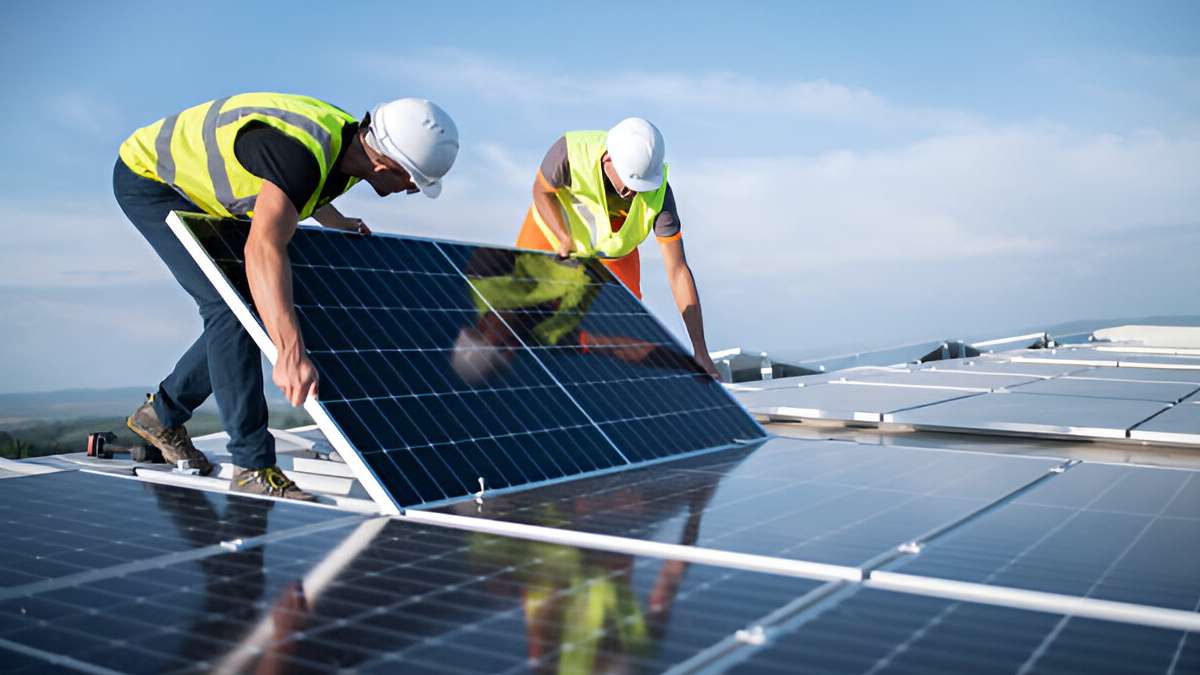Ever stared at your electricity bill and wondered if there’s gotta be a better way? Trust me, I’ve been there. Last month, my friend Raju showed me his electricity bill – it was literally ₹200 for the entire month. Meanwhile, I’m here paying ₹3,500 for running the AC during Hyderabad’s brutal summer. The difference? He installed rooftop solar power six months ago.
With the government’s new PM Surya Ghar Yojana making solar more affordable than ever, I decided it’s time to dig deep into this whole solar thing. Here’s everything I’ve learned about getting solar panels for your home, and honestly, some of this stuff surprised me.
Table of Contents
ToggleWhat’s All This Buzz About PM Surya Ghar Yojana?
So the government just launched this massive scheme called PM Surya Ghar: Muft Bijli Yojana, and it’s pretty wild. They’re basically throwing ₹75,000 crores at making solar power accessible to regular folks like us.
Here’s the deal – they want to light up 1 crore households by giving up to 300 units of free electricity every month. Yeah, you read that right. Free electricity.
The scheme works like this:
- Subsidies up to ₹78,000 for residential solar installations
- Low-interest loans to cover the remaining costs
- Net metering so you can sell excess power back to the grid
- Simplified approval process (finally, less paperwork!)
I’ve been tracking this since the announcement, and honestly, it’s the biggest push for residential solar I’ve seen in India.
Why Rooftop Solar Power Makes Sense Right Now
Look, I’m not gonna sugarcoat this – solar isn’t magic. But the math is starting to make a lot of sense, especially with rising electricity costs.
The Money Talk
Here’s what I found when I ran the numbers for a typical 3kW system:
- Initial cost: Around ₹1.8-2.4 lakhs (before subsidies)
- After PM Surya Ghar subsidy: ₹1.2-1.8 lakhs
- Monthly savings: ₹2,000-4,000 (depending on your current usage)
- Payback period: 4-6 years
My friend Uday in Bangalore installed a 5kW system last year. His monthly bill dropped from ₹4,500 to ₹800. Do the math – that’s ₹44,400 saved per year.
Beyond Just Money
But it’s not just about the bills. There’s something satisfying about generating your own power. Plus:
- No more load-shedding worries (with battery backup)
- Property value increase (yes, homes with solar sell for more)
- Environmental impact (if that matters to you)
- Energy independence (feels good, honestly)
Different Types of Solar Panel Systems for Home
When I started researching, I was confused by all the different types. Let me break it down simply:
Grid-Tied Systems (Most Popular)
This is what most people get. Your solar panels connect directly to the electricity grid.
Pros:
- Cheapest option
- Sell excess power back to utility company
- No battery maintenance
Cons:
- No power during outages (safety feature)
- Dependent on grid stability
Off-Grid Systems (Complete Independence)
You’re totally disconnected from the main grid. Everything runs on solar and batteries.
Pros:
- Complete energy independence
- Works during power cuts
- Great for remote locations
Cons:
- Expensive (batteries cost a lot)
- Need to size system perfectly
- Battery replacement every 5-7 years
Hybrid Systems (Best of Both Worlds)
Connected to grid but with battery backup. This is what I’m leaning towards.
Pros:
- Power during outages
- Can sell excess to grid
- Flexible operation
Cons:
- Most expensive option
- More complex installation
How to Choose the Right Solar Panel for Your Home
This part gave me a headache initially. There are so many options, brands, and specifications. Here’s what actually matters:
System Size (Most Important Decision)
Start with your electricity bill. Look at your monthly units consumed.
- 1-2 kW: Small homes, 150-300 units/month
- 3-5 kW: Medium homes, 300-600 units/month
- 5-10 kW: Large homes, 600+ units/month
I use about 450 units monthly, so a 4kW system makes sense for me.
Panel Type
There are three main types:
Monocrystalline (What I’d choose)
- Most efficient
- Take up less roof space
- Cost more but worth it
Polycrystalline (Budget option)
- Decent efficiency
- Slightly more space needed
- Good value for money
Thin Film (Skip these)
- Least efficient
- Need lots of space
- Only good for specific situations
Inverter Selection
This converts DC power from panels to AC power for your home. Don’t cheap out here.
String Inverters: One inverter for whole system (most common) Power Optimizers: Better performance, slightly more expensive
Microinverters: Best performance, most expensive
Working with Solar Companies: What I Learned
I’ve been talking to various solar companies, and honestly, the experience varies wildly. Some are super professional, others feel like they’re just trying to make a quick buck.
One company that impressed me is AMB Green Energy (ambgreenenergy.com). I reached out to them after seeing their work in my area, and they actually took time to explain everything without the typical sales pressure. Sunil, their representative (+919392293942), was particularly helpful in breaking down the PM Surya Ghar subsidy process. They handle everything from design to installation to paperwork for the subsidies.
Questions to Ask Every Company:
- What’s the total cost breakdown?
- How do you handle PM Surya Ghar subsidy applications?
- What’s included in warranty and for how long?
- Can you show me similar installations nearby?
- What happens if panels underperform?
The Installation Process: What Actually Happens
I visited a friend’s house during his installation to see what goes down. Here’s the real timeline:
Week 1-2: Planning and Approvals
- Site survey and system design
- Subsidy applications (PM Surya Ghar paperwork)
- Net metering approvals from electricity board
Week 3: Installation Day
- Early morning start (beat the heat)
- Roof mounting structure installation
- Panel mounting and wiring
- Inverter and monitoring system setup
- Initial testing
Week 4-6: Final Connections
- Electricity board inspection
- Net meter installation
- System commissioning
- Handover and training
The actual installation took just one day, but the paperwork and approvals? That’s where time gets eaten up.
Rooftop Solar Power Maintenance: Less Than You Think
Here’s something that surprised me – solar panels need very little maintenance.
Monthly Tasks:
- Visual inspection (cracks, loose connections)
- Performance monitoring (most systems have apps now)
- Basic cleaning (if accessible safely)
Quarterly Tasks:
- Professional cleaning (especially in dusty areas)
- Detailed performance review
- Connection tightening
Annual Tasks:
- Professional inspection
- Inverter servicing
- Warranty claim reviews
My neighbor spends maybe 2 hours per month on maintenance. That’s it.
Common Rooftop Solar Myths I Had to Unlearn
Before I started researching, I believed some pretty silly stuff:
Myth: “Solar doesn’t work in monsoon” Reality: Panels work fine in rain, just produce less power. One cloudy day won’t kill your savings.
Myth: “Installation damages the roof” Reality: Proper installation actually protects your roof. Just hire professionals.
Myth: “Solar panels need constant cleaning” Reality: Rain does most of the work. Monthly cleaning is plenty.
Myth: “Technology changes too fast, better to wait” Reality: Today’s panels will work fine for 25+ years. Don’t wait for “better” technology.
Myth: “Too expensive for middle-class families” Reality: With PM Surya Ghar subsidies and financing, monthly EMI can be less than current electricity bills.
Is Rooftop Solar Power Worth It in 2025?
After months of research and talking to actual users, here’s my honest take:
If you have these, go for it:
- South-facing roof with minimal shading
- Monthly electricity bill over ₹2,000
- Plan to stay in the house for 5+ years
- Decent roof condition
Maybe wait if:
- Your roof needs major repairs
- You’re planning to move soon
- Your electricity usage is very low
- Building has height restrictions
For most homeowners dealing with rising electricity costs, the PM Surya Ghar Yojana makes solar a no-brainer. The subsidies are real, the technology is proven, and the savings add up fast.
Getting Started: Your Next Steps
If you’re convinced (like I am), here’s what to do:
- Calculate your needs using past electricity bills
- Get quotes from 3-4 companies (including AMB Green Energy if they’re in your area)
- Check roof suitability (structural engineer if needed)
- Apply for PM Surya Ghar subsidy (your installer can help)
- Arrange financing if needed
- Schedule installation
The whole process takes 2-3 months from decision to generating power.
The Bottom Line on Rooftop Solar Power
Look, I’m not saying solar is perfect. There’s upfront cost, some maintenance, and occasional headaches with bureaucracy. But with electricity costs rising every year and the government actually supporting solar through PM Surya Ghar Yojana, the timing feels right.
My neighbor Raj wishes he’d installed his system two years earlier. At the rate he’s saving money, his system will pay for itself by next year. Meanwhile, I’m still paying full price for grid electricity like a chump.
The way I see it, rooftop solar power isn’t just about saving money anymore – it’s about taking control of your energy costs before they spiral completely out of hand. And with schemes like PM Surya Ghar making it affordable, there’s never been a better time to make the switch.
Also Read: Discovering The Upsides and Downsides of Smart Switches
Shashi Teja
Related posts
Hot Topics
Key Trends in Facility Management to Achieve Productivity Growth
Facilities management is now at a crossroads, where it must enhance productivity, at the same time operating in more dynamic…
How Can You Lend Money Online to Generate a Parallel Income
Making additional revenue in today’s digital economy is easier than ever. Peer-to-peer lending services are becoming more and more popular….



